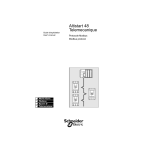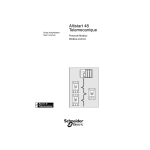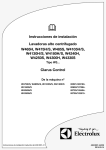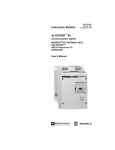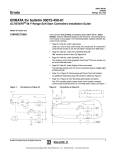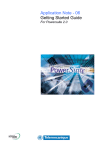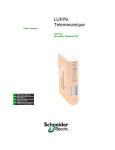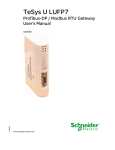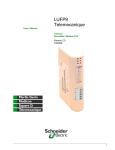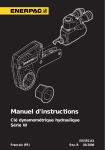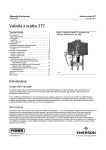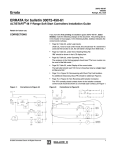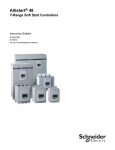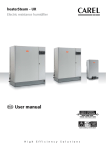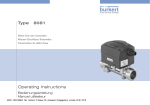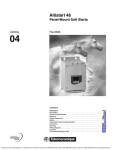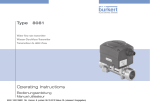Download ATS 48 User Manual Modbus Protocol
Transcript
Altistart 48 Guide d'exploitation User manual Protocole Modbus Modbus protocol 1623736 10/2009 www.schneider-electric.com Contents Introduction ____________________________________________________________________ 62 Connection to RS485 Bus _________________________________________________________ 63 Connection to ATS48 ______________________________________________________ Wiring recommendations ___________________________________________________ Pinouts _________________________________________________________________ Modbus Protocol ________________________________________________________________ 63 65 65 66 Configuration of the serial link _______________________________________________ RTU mode ______________________________________________________________ Principle ________________________________________________________________ Addresses ______________________________________________________________ Modbus functions _________________________________________________________ Read N words: functions 3 and 4 _____________________________________________ Write one output word: function 6 _____________________________________________ Write N output words: function 16 (16#10) ______________________________________ Identification: function 65 (16#41) ____________________________________________ Exception responses ______________________________________________________ CRC16 calculation ________________________________________________________ Parameter Representation _________________________________________________________ 66 66 67 67 68 69 69 70 70 71 71 72 Control Modes __________________________________________________________________ 75 DRIVECOM Profile _______________________________________________________________ 78 78 80 81 82 ENGLISH DRIVECOM status chart ___________________________________________________ CMD control register (W400) ________________________________________________ ETA status register (W458) _________________________________________________ Adjustment Parameters ___________________________________________________________ Protection Parameters ____________________________________________________________ 86 Advanced Adjustment Parameters ___________________________________________________ 90 I/O Parameters __________________________________________________________________ 93 2nd Motor Parameters ____________________________________________________________ 96 Communication Parameters ________________________________________________________ 97 Control Parameters ______________________________________________________________ 98 Displayed Parameters ___________________________________________________________ 100 Monitoring Parameters ___________________________________________________________ 102 Identification Parameters _________________________________________________________ 106 Compatibility with ATS46 _________________________________________________________ 107 Principle _______________________________________________________________ 107 Index of parameters _____________________________________________________________ 113 Alphabetical index of codes ________________________________________________ 113 Alphabetical index of logical addresses _______________________________________ 114 Alphabetical index of names _______________________________________________ 115 1623736 10/2009 64 Introduction The Modbus socket on the Altistart 48 can be used for the following functions: • • • • Configuration Adjustment Control Monitoring The ATS48 starter supports: • The RS485 physical layer • RTU mode Modbus services, operating modes and communication variables are described in the following sections. ENGLISH The ATS48 is interchangeable with an ATS46 used in Modbus RTU mode (see ATS46 Compatibility section). 65 1623736 10/2009 Connection to RS485 Bus Connection to ATS48 Connection accessories should be ordered separately (please consult our catalogues). Connect the RJ45 cable connector to the ATS48 connector 1. RJ45 connector ENGLISH 1 1623736 10/2009 66 Connection to RS485 Bus Example of connection Various accessories are available from the Schneider Automation catalogue to aid connection of equipment. Connection to TSXSCA62 and TSXSCA50 boxes is one example of the different Modbus connection options (please consult our catalogues). - Shielded double twisted pair cable: TSXCSA100 (100 m) TSXCSA200 (200 m) TSXCSA500 (500 m) - TSXSCA62 2-channel subscriber socket: This passive box enables connection to 2 screw terminals and 2 female 15-pin SUB-D connectors. It includes the line termination, required when the socket is located at an end of the line. - TSXCAS0 junction box: This passive box enables connection to 3 screw terminals. It includes line termination. - Drop cable: VW3A8306, length 3 m, fitted with 2 connectors (RJ45 and male 15-pin SubD). VW3A8306D30, length 3 m, fitted with one RJ45 connector, the other end stripped. TSXSCA62 TSXSCA50 ENGLISH TSXCSA¥00 VW3A8306 PC VW3A8306D30 Altistart 48 67 Altistart 48 Altistart 48 1623736 10/2009 Connection to RS485 Bus Wiring recommendations • • • • • Use a shielded cable with 2 pairs of twisted conductors Connect the reference potentials (0V) to one another Maximum length of line: 1000 metres Maximum length of tap-off: 20 metres Cable routing: Keep the bus away from the power cables (at least 30 cm) with any crossovers at right-angles if necessary, and connect the cable shielding to the ground of each device. • Fit a line terminator at both ends of the line. 120 ¾ D(A) Line termination recommended at both ends of the line 1 nF D(B) • Each ATS48 integrates two 4.7 kohm pulldown resistors which improve bus immunity. If the master is also fitted with 4.7 kohm pulldown resistors, up to 27 starters can be connected. If the pulldown resistors on the master are 470 ohm, up to 18 starters can be connected. Pinouts • VW3A8306 cable for TSXSCA62 RJ45 RJ45 D (B) 4 D (B) 4 14 D (A) 5 D (A) 5 7 0V 8 15 10 V 7 0V 8 1623736 10/2009 Male 15-pin SUB-D ENGLISH • ATS48 socket 68 Modbus Protocol Configuration of the serial link Configuration of the serial link parameters can be accessed from the Communication menu COP Parameters Possible values Terminal display Default value Protocol (COP) Modbus RTU RTU RTU Address Add 0 to 31 000 to 031 0 Speed tbr 4800 9600 19200 48 96 192 19200 bps Format FOr 8 data bits, odd parity, 1 stop bit 8 data bits, even parity, 1 stop bit 8 data bits, no parity, 1 stop bit 8 data bits, no parity, 2 stop bits 8O1 8E1 8n1 8n2 8n1 RTU mode The transmission mode used is RTU mode. The frame contains no message header byte, nor end of message bytes. It is defined as follows: ENGLISH Slave address Request code Data CRC16 The data is transmitted in binary code. CRC16: cyclical redundancy check parameter. The end of the frame is detected if silent for Š 3 characters. 69 1623736 10/2009 Modbus Protocol Principle Modbus protocol is a master-slave protocol. Master Only one device can transmit on the line at any time. The master manages the exchanges and only it can take the initiative. It interrogates each of the slaves in succession. No slave can send a message unless it is invited to do so. The master repeats the question when there is an incorrect exchange, and declares the interrogated slave missing if no response is received within a given time period. If a slave does not understand a message, it sends an exception response to the master. The master may or may not repeat the request. Slave i Slave j Slave k Direct slave-to-slave communications are not possible. For slave-to-slave communication, the application software must have been purposely designed: to interrogate one slave and send back data received to the other slave. Two types of dialogue are possible between master and slaves: ENGLISH • the master sends a request to a slave and waits for its response • the master sends a request to all slaves without waiting for a response (broadcasting principle). Addresses The slave address can have a value between 0 and 31. Address 0: • Address 0 coded in a request sent by the master is reserved for broadcast communication. All slaves, including the ATS48, take account of the request, but do not respond to it. • When the ATS48 has been configured with address 0 (default value), it takes account of requests addressed between 1 and 31 and responds to the same address as each of these requests. As a result, the starter behaves as if it were configured on all the possible addresses (1 to 31). This default configuration should only be retained if point-to-point connection is being used, ie. mainly with connection to a PC. An address other than 0 should be configured on a Modbus network which includes other slaves. Addresses 126 and 127: Addresses 126 and 127 constitute privileged addresses. No Modbus master should therefore use either of these addresses in requests generated on a Modbus network incorporating at least one Altistart 48. Address 126 is reserved for communication with a terminal and address 127 is reserved for exchanges with PowerSuite. Both of these should only be used on a point-to-point link. 1623736 10/2009 70 Modbus Protocol Modbus functions The following table indicates which Modbus functions are managed by the Altistart 48, and specifies their limits. The "read" and "write" functions are defined from the point of view of the master. Code (decimal) Function name Broadcast communication Max. value of N Modbus standard name 3 Read N output words NO 30 words max. Read Holding Registers 4 Read N input words NO 30 words max. Read Input Registers 6 Write one output word YES – Preset Single Register 16 Write N output words YES 30 words max. Preset Multiple Regs 65 Identification NO – – ENGLISH The Identification function is specific to ATV drives and ATS starters. 71 1623736 10/2009 Modbus Protocol Read N words: functions 3 and 4 Note: Hi = high order byte, Lo = low order byte. Read N output words: function 3 Read N input words: function 4 Request Slave no. 1 byte Response Slave no. 1 byte No. of 1st word Hi Lo 2 bytes 03 or 04 1 byte 03 or 04 1 byte Number of bytes read 1 byte Number of words Hi Lo 2 bytes Value of 1st word Hi Lo 2 bytes CRC16 Lo Hi 2 bytes Last word value Hi Lo 2 bytes ------- CRC16 Lo Hi 2 bytes Example: read 4 words W4023 to W4026 (16#0FB7 to 16#0FBA) in slave 2, using function 4, with: • LO1 = Motor thermal alarm tAI (W4023 = 16#0001) • AO = Motor current OCr (W4024 = 16#0001) • ASC = 200% (W4025 = 16#00C8) • In = 1.0 x starter rating ICL (W4026 = 16#000A) 02 Response 02 04 0FB7 04 08 Value of: Parameters: 0004 0001 W4023 LO1 42C8 0001 W4024 AO 00C8 W4025 ASC 000A W4026 In 07B0 ENGLISH Request Write one output word: function 6 Request and response (the frame format is identical) Slave no. 1 byte 06 1 byte Word number Hi Lo 2 bytes Value of word Hi Lo 2 bytes CRC16 Lo Hi 2 bytes Example: write value 16#000D in word W4043 of slave 2 (ACC = 13 s). Request and response 1623736 10/2009 02 06 0FCB 000D 3AD6 72 Modbus Protocol Write N output words: function 16 (16#10) Request Slave 10 no. 1 byte 1 byte Response Slave no. 1 byte 10 1 byte No. of 1st word Hi Lo 2 bytes Number Number of words of bytes 2 bytes 1 byte No. of 1st word Hi Lo 2 bytes Number of words Hi Lo 2 bytes Value of 1st word Hi Lo 2 bytes CRC16 ------- Lo Hi 2 bytes CRC16 Lo Hi 2 bytes Example : write values 20 and 30 in words W4043 and W4044 of slave 2 (ACC = 20 s and DES = 30 s) Request 02 10 0FCB 0002 04 0014 Response 02 10 0FCB 0002 3311 001E 30F4 Identification: function 65 (16#41) This function is used to obtain additional information to the parameters described in the “Product characteristic parameters” section. ENGLISH Request Slave no. 1 byte Response Slave no. 1 byte ------- ------- CRC16 41 Lo 1 byte 41 1 byte Hi 2 bytes Length of name of manufacturer (F) 1 byte Length of name of product (P) 1 byte Manufacturer name (in ASCII) Byte 0 … Byte F–1 F bytes Product name (in ASCII) Byte 0 … Byte M–1 P bytes Bits 4-7: Software version Bits 0-3: Version subdeterminant no. 1 byte ------- Product reference name (ASCII) ------Byte 0 … Byte 10 11 bytes UI (upgrade index of the software) 1 byte Note: The response to function 6 is always positive, ie. the slave cannot send back an exception response. Example: following the request from the Modbus master, slave 2 identifies itself as follows: • Manufacturer name (F = 13 = 16#0D): “TELEMECANIQUE” • Product name (P = 12 = 16#0C): “ALTISTART 48” • Product reference name: “ATS48D17Q” • Software version (version . subdeterminant number): 1.1 • Software upgrade index: 01 73 1623736 10/2009 Modbus Protocol Request 02 Response 41 02 ------- 0C ------- 11 C0E0 41 0D 54 45 4C 45 4D 45 43 41 4E 49 51 55 45 41 4C 54 49 53 54 41 52 54 20 34 38 01 41 54 53 2D 34 38 44 31 37 51 20 ------------- 2C81 Exception responses An exception response is returned by a slave when it is unable to perform the request which is addressed to it. Format of an exception response: Slave no. Response code Error code 1 byte 1 byte 1 byte CRC16 Lo Hi 2 bytes Response code: request function code + H’80. ENGLISH Error code: 1 = The function requested is not recognized by the slave. 2 = The bit or word addresses indicated in the request do not exist in the slave. 3 = The bit or word values indicated in the request are not permissible in the slave. 4 = The slave has started to execute the request but cannot continue to process it completely. CRC16 calculation The CRC16 is calculated on all the message bytes by applying the following method: Initialize the CRC (16-bit register) to 16#FFFF. Enter the first to the last byte of the message: CRC XOR Enter 8 times <byte> —> CRC Move the CRC one bit to the right If the output bit = 1, enter CRC XOR 16#A001—> CRC End enter End enter The CRC obtained will be transmitted with the low bytes sent first, then the high bytes (unlike the other data contained in Modbus frames). XOR = exclusive OR. 1623736 10/2009 74 Parameter Representation Document structure The information concerning parameters is supplementary to the Altistart 48 – Soft start - soft stop units user’s manual. This manual should be consulted for the starter hardware and software setup. The parameters are arranged in the same order in both manuals. Several indices, located at the end of the document, can be used to search for parameter codes in alphabetical order, addresses in ascending order and parameter names in alphabetical order. Key to tables Code Address TQ0 W4037 Name Initial starting torque Unit 0.1 A Range 0 to 100 (% of the nominal motor torque Tn) Factory setting 20 This parameter can only be accessed if CLP is set to On (W4107 = 1). It can be used to adjust the initial torque level during starting phases. )* !! &! '! "#! $ %! %! (! Time (s) ENGLISH ! ! STY W4029 +,, Selection of the stop type 0 to 2 0 The selected type of stop is applied, for example, on deactivating the logic input LI_STOP. - 0 = -F-: Freewheel stop: No torque is applied to the motor by the starter. - 1 = -d-: Stop by torque control during deceleration: The starter applies a motor torque for gradual deceleration on the ramp, avoiding a sudden stop if the resistive torque is high (example: water hammer with a pump). - 2 = -b-: Dynamic braking stop: The starter generates a braking torque in the motor which will slow the motor down if there is considerable inertia. If the starter is connected to the delta motor winding, stop type b is not permitted. Note : Soft stopping by control of torque (type d) is available since V1.2IE13. "- 0 = -F-: Freewheel stop" ’0’ is the parameter value -F- is the soft starter terminal display 75 1623736 10/2009 Parameter Representation Representation of data The ATV48 parameters are 16-bit words designated by "W…" (…address in decimal notation). They are used to represent unsigned values (0 to 65535), ie. 16 independent logic states. In this case, they are called "registers", and the notation for their bits is "W…:xk" (k bit number, from 0 to 15). Example: W4028 = Voltage boost level W402 = Status register W402:X2 = Bit 2 of the status register Values given in hexadecimal notation are written as 16#… This notation is equivalent to the H…, H’…’, …k and 0x… notations sometimes used in other documents. 2#… … … … is binary representation. Access to data Some parameters can be accessed in both write mode and read mode: these are the parameters corresponding to adjustments, configurations or commands. These parameters are used by the starter. Data generated by the starter can only be accessed in read mode: signalling and fault information, etc. Any attempt to write it results in nonsense, which the starter will reject. Initializing values When LINE Mode is active, the following commands can be performed on the parameters: • Storage of these adjustments in the EEPROM is controlled via Bit 1 of CMI (W402:X1), active on rising edge 0 Õ 1. • Return to factory settings is controlled via Bit 0 of CMI (W402:X0), active on rising edge 0 Õ 1. • Return to adjustments previously stored in the EEPROM (using Bit 1 of CMI) is controlled via Bit 2 of CMI (W402:X2), active on rising edge 0 Õ 1. Reserved parameters Only the addresses and values defined in this document can be used. Any other address or value must be considered to be reserved and must never be written. Failure to observe this precaution may result in starter malfunctions. Reading an existing memory zone which is not assigned to a parameter returns a value of 16#8000. 1623736 10/2009 76 ENGLISH On each power-up, the Altistart 48 is initialized with the configuration and adjustments stored in its EEPROM memory. Control Modes Description of Control Modes The Altistart 48 can be controlled in three different modes: • LOCAL mode: The starter is entirely controlled via the terminals. The parameters can be read and written via Modbus. Writing the control register does not affect starter operation. • FORCED LOCAL mode: The starter is entirely controlled via the terminals. Write access to the parameters from the Modbus link is prohibited. Reading is possible. • LINE mode: The starter is entirely controlled by the control register. Only the STOP logic input remains active at the terminals and has priority. There are two LINE mode profiles: - DRIVECOM profile - ATS46 profile The DRIVECOM profile is compatible with applications developed for variable speed drives. The ATS46 profile is reserved for compatibility with the ATS46 soft starter (see "ATS46 compatibility" section). A control mode is said to be active at a given moment if it determines the starter status. Control mode parameter settings ENGLISH The following parameters are some of those which it is useful to be familiar with in order to manage an Altistart 48 when LINE mode is active. 77 Parameter Address Type Bits 8 and 15 of CMD W400:X8 W400:X15 Control Description CMI.NTO W402:X14 Control LI3 LI4 W4022 W4048 Configuration Assignment of logic input LI3 or LI4, to FORCED LOCAL (LIL / value = 4). STY W4029 Configuration Setting the stop type parameters via LI_STOP or the control register. The selected stop is applied to the FORCED LOCAL input and to the output. Bit 14 of ETI W459:X14 Monitoring LINE mode activity indicator (indicator active at 1). Bit 9 of ETA W458:X9 Monitoring FORCED LOCAL activity indicator (indicator active at 0). Bit 0 of IOL Bit 9 of IOL W4066:X0 W4066:X9 Monitoring State of logic input LI3 (Bit 0) or LI4 (Bit 9). (0 = low state, 1 = high state) Bit 8=0 and Bit 15=0 o LINE mode/Drivecom profile. Bit 8=1 and Bit 15=1 o LOCAL mode. Suppression of Modbus link control. 1623736 10/2009 Control Modes Control modes status chart Key ACTIVE MODE Profile Origin of control commands and Starter actions 0 Deactivation of "FORCED LOCAL" logic input LOCAL MODE 4 Commands accepted via terminals Writing and reading possible via the line ETI (W459)= 2# x00x xxxx xxxx xxxx ETA (W458)= 2# xxxx xx1x xxxx xxxx Write CMD = 2#0xxx xxx0 xxxx xxxx 1 Communication fault (SLF) 2 or Change to LOCAL mode CMD = 2#1xxx xxx1 xxxx xxxx 5 Activation of "FORCED LOCAL" logic input Transition X condition FORCED LOCAL MODE Input: Stopping according to the type of stop configured. Active state: Commands accepted via terminals. Writing by the line not possible. Output: Stopping according to the type of stop configured. ETI (W459) =2# x00x xxxx xxxx xxxx ETA (W458) =2# xxxx xx0x xxxx xxxx ENGLISH Enter the chart LINE MODE DRIVECOM profile Acceptance of CMD register 3 commands (W400), according to the Activation of "FORCED LOCAL" logic input DRIVECOM chart Writing and reading possible via the line ETI (W459) = 2# x11x xxxx xxxx xxxx 1623736 10/2009 78 Control Modes Communication fault The starter changes to LINE mode as soon as the control register is received (transition 1 on the chart). For LINE mode to remain active, it is necessary to send messages to the starter regularly. A message (irrespective of type) must be received at least every 2 seconds; this minimum period can be adjusted using the timeout adjustment parameter for the TLP serial link (W2295 max. value = 60 s). It may be necessary to modify this parameter if there are a number of subscribers on the same Modbus network. If no message is received, this causes a starter serial link fault, SLF (W4200 = 5), change from LINE mode to LOCAL mode, as well as reinitialization of the CMD (W400) and CMI (W402) control registers in the starter. ENGLISH The CMI.NTO bit (W402:X14), active at 1, can be used to inhibit communication control. If NTO = 1, the starter no longer takes account of communication errors coming from the RS485 serial link (Modbus link), and the SLF fault never appears. For obvious safety reasons, use of the NTO bit should be reserved for the debug phase or for special applications. 79 1623736 10/2009 DRIVECOM Profile ENGLISH DRIVECOM status chart (1) The CMD and ETA register values are only given as examples. See following pages for description of these register bits. (2) With automatically resettable faults: On an automatic reset, the status chart changes from the "Malfunction" state to the "Switch on disabled" state without it being necessary to issue a fault reset command. 1623736 10/2009 80 DRIVECOM Profile The status chart changes according to control register CMD (W400), or following the appearance of an event (for example: excessive starting time). The starter status is given by status register ETA (W458). Not ready to switch on (Initialization): This state characterizes initialization of communication, once power is supplied to the Altistart 48. It is not visible, since it constitutes a transient state which occurs during initialization. Switch on disabled (Configuration): The starter is locked. The configuration and adjustment parameters can be modified. If all or part of the configuration and adjustments are to be loaded, we recommend disabling the parameter consistency check function during parameter transfer by activating Bit 15 of CMI (W402:X15 = 1). Once the transfer is complete, the consistency check should be enabled by deactivating the same boolean operator (W402:X15 = 0); the check is then made immediately and affects all parameters. Ready to switch on and Switched on: The starter is locked. The configuration and adjustment parameters can be modified. But if any of them are modified while in the "Switched on state", this causes a return to the “Switch on disabled” state. Operation enabled (Operational): The starter drive functions are activated. ENGLISH This is the only state in which the voltage upstream of the starter is possibly applied to the motor terminals. In all states, the power supply can be applied. It is possible to reach the "Operation enabled" state without the power supply having been established. Bit 4 of ETA (W458:X4) is used to determine whether the voltage is applied (0) or not (1) to the starter terminals. The starter display unit indicates “NLP” if the power supply is missing. The configuration and adjustment parameters can only be modified when the motor is stopped and no voltage is applied to the motor terminals. Modification of one of these parameters causes a return to the “Switch on disabled” state. Only the control parameters can be modified while the motor is powered up and running. Any attempt to write the value of a configuration or adjustment parameter will be rejected if voltage is applied to the motor terminals. Quick stop active (Emergency stop active): Freewheel stop. Restarting is only possible after changing to the “Switch on disabled” state. Malfunction reaction active (Reaction on fault): Transient state during which the starter performs an action appropriate to the type of fault. Freewheel stop. The drive function is disabled. Malfunction (Fault): Faulty starter. End of freewheel stop caused by change to the previous state "Malfunction reaction active". The drive function is disabled. 81 1623736 10/2009 DRIVECOM Profile CMD control register (W400) Bit 14 0 Decelerated (Drivecom) stop Bit 13 Bit 12 Bit 11 Bit 10 Bit 9 Bit 8 Braked stop (BRL) Stop (STY) Activation of cascade function 0 0 0 Bit 1 Bit 0 Bit 7 Bit 6 Bit 5 Bit 4 Bit 3 Bit 2 Reset faults (0 o 1) 0 0 0 Enable operation Quick stop (active at 0) Disable Switch on Voltage (active at 0) Bit 7 Bit 3 Bit 2 Bit 1 Bit 0 Reset faults Enable operation Quick stop Disable voltage Switch on Example of CMD (W400) Ready to switch on x x 1 1 0 16#0006 3 Switched on x x 1 1 1 16#0007 Enable operation 4 Operation enabled x 1 1 1 1 16#000F Disable operation 5 Switched on x 0 1 1 1 16#0007 Disable voltage 7, 9, 10, 12 Switch on disabled x x x 0 x 16#0000 11 Quick stop active Switch on disabled x x 0 1 x 16#0002 7, 10 15 Switch on disabled 0Õ1 x x x x 16#0080 Command Transition address Final state Shutdown 2, 6, 8 Switch on Quick stop Fault reset x 0Õ1 State not significant Change from 0 to 1 Normally, different stops should not be requested in the same command. However, the following order of priority is applied: • Freewheel stop (higher priority) • … • … 1623736 10/2009 82 ENGLISH Bit 15 DRIVECOM Profile ETA status register (W458) Bit 15 0 Bit 7 Alarm Bit 14 0 Bit 13 0 Bit 12 0 Bit 6 Bit 5 Bit 4 Switch on Quick stop No power * disabled (active at 0) Bit 11 0 Bit 10 0 Bit 3 Bit 2 Malfunction Operation enabled Bit 9 Line mode control Bit 8 0 Bit 1 Switched on Bit 0 Ready to switch on * This status bit corresponds to the “Voltage disabled” item (active at 1) of the Drivecom generic profile. With the starter, if this bit is at 0, it means that the line voltage is applied upstream. If it is at 1, the starter is not receiving this voltage; its terminal display then indicates “NLP”, if no other display has higher priority (fault, for example). Bit 6 Bit 3 Bit 2 Bit 1 Bit 0 ETA (W458) Quick stop Malfunction Operation enabled Switched on Ready to switch on Masked by 16#006F 0 x 0 0 0 0 16#0000 16#0020 Switch on disabled 1 x 0 0 0 0 16#0040 16#0060 Ready to switch on 0 1 0 0 0 1 16#0021 Switched on 0 1 0 0 1 1 16#0023 Operation enabled 0 1 0 1 1 1 16#0027 Malfunction 0 x 1 0 0 0 16#0008 16#0028 Malfunction reaction active 0 x 1 1 1 1 16#000F 16#002F Quick stop active 0 0 0 1 1 1 16#0007 ENGLISH State Switch on disabled Not ready to switch on Bit 5 x: Can take the value 0 or 1 83 1623736 10/2009 Adjustment Parameters The adjustment parameters can be accessed in both read and write mode. These parameters can only be modified with the motor stopped. They correspond to those parameters which can be accessed from the starter terminal SEt menu. Code Address IN W4026 ILT W4039 Name Nominal motor current Unit 0.1 A Range 0.4 to 1.3 ICL Factory setting (1) Adjust the value of the nominal motor current indicated on the rating plate, even if the starter is connected in the motor delta winding (dLt in the PrO menu). Check that this current is between 0.4 and 1.3 ICL (ICL: Starter rating (W4503)). Limiting current % 150 to 700 400 The limiting current ILt is expressed as a % of In. It is limited to 500 % of the starter rating ICL (W4503). Limiting current = ILt x In. Example 1: In = 22 A, ILt = 300%, limiting current = 300% x 22 A = 66 A Example 2: ATS 48C21Q, with ICL = 210 A In = 195 A, ILt = 700%, limiting current = 700% x 195 = 1365, limited to 500% x 210 = 1050 A ACC W4043 Acceleration ramp time s 1 to 60 15 This is the rise time for the starting torque between 0 and the nominal torque Tn. 100 Reference torque as a % of Tn 80 ENGLISH 60 40 20 Time (s) 0 0 ACC (1) ATS48•••Q: The factory setting of IN corresponds to the usual value of a 4-pole 400 V standardized motor with class 10 protection (see parameter THP / W4034). ATS48•••Y: The factory setting of IN corresponds to the usual value of a 460 V standardized motor according to NEC, with class 10 protection (see parameter THP / W4034). 1623736 10/2009 84 Adjustment Parameters Code Address TQ0 W4037 Name Unit Initial starting torque % Range 0 to 100 Factory setting 20 This parameter can only be accessed if CLP is set to On (W4107 = 1). Initial torque setting during the starting phases, varies from 0 to 100% of the nominal torque Tn. )* !! &! The maximum value of TQ0 is limited by TLI (W4036) '! "#! $ %! %! (! Time (s) ! ! STY W4029 +,, Selection of the stop type 0 to 2 0 The selected stop type is applied, for example, when the logic input LI_STOP is deactivated. - 0 = -F-: Freewheel stop: No torque is applied to the motor by the starter. ENGLISH - 1 = -d-: Decelerated stop using torque control. The starter applies a motor torque for gradual deceleration on the ramp, avoiding a sudden stop. This stop type is an effective means of reducing water hammer in a pump. - 2 = -b-: Dynamic braking stop: The starter generates a braking torque in the motor which will slow the motor down if there is significant inertia. Only stop type -F- is authorized if the motor delta winding connection function has been selected (DLT = On / W4054 = 1). DEC W4044 Deceleration ramp time s 1 to 60 15 This parameter is only used if a decelerated stop has been configured (STY = -d- / W4029 = 1). It can be used to set a time between 1 and 60 s, for changing from the estimated torque to zero torque. This makes deceleration more or less gradual, and avoids hydraulic shocks in pump applications by modifying the gradient of the torque reference. Estimated torque as a % of the nominal torque 100 80 60 40 20 Time (s) 0 dEC 85 1623736 10/2009 Adjustment Parameters Code Address EDC W4038 Name Unit Threshold for changing to freewheel stop mode at the end of deceleration % Range 0 to 100 Factory setting 20 This parameter can only be accessed if StY = -d- (W4029 = 1) and if parameter CLP in the drive menu (drC) is still set to the factory setting (On) (W4107 = 1). Used to set the final torque level between 0 and 100% of the torque estimated at the beginning of deceleration. In pump applications, deceleration control is not necessarily effective below a load level set by Edc. If the estimated torque at the start of deceleration is below 20, i.e. 20% of the nominal torque, controlled deceleration is not activated, and the motor changes to freewheel mode. Estimated torque as a % of the nominal torque 100 80 60 End of controlled deceleration 40 EdC 20 Time (s) 0 ENGLISH dEC 1623736 10/2009 86 Adjustment Parameters Code Address BRC W4041 Name Unit Internal braking torque level % Range 0 to 100 Factory setting 50 This parameter is only used if a dynamic braking stop has been configured (STY = -b- / W4029 = 2). BRC is then used to set the braking current. Braking is active up to 20% of nominal speed. The total motor stop is configured by adjusting the pseudo-continuous current injection time in the motor (on two phases). See next parameter: EBA (W4042). 100 % Motor speed brc = 0 brc = 100 20 % 0 T1 T2 ENGLISH Dynamic Adjustment of motor braking time stop by EbA Pseudo-continuous injection time: T2 = T1 x EBA Note: Time T1 is not determined by BRC. T1 is the time required in seconds for the motor to fall from 100% of the nominal speed to 20% (depends on the motor and application characteristics). EBA W4042 87 Pseudo-continuous braking time % 20 to 100 20 This parameter is only used if a dynamic braking stop has been configured (STY = -b- / W4029 = 2). EBA is then used to adjust the current injection time at the end of braking. Example: Dynamic braking = 10 s (T1) The stopping time can vary from 2 to 10 s (T2) EBA = 020 o Corresponds to an injection time of 02 s EBA = 100 o Corresponds to an injection time of 10 s 1623736 10/2009 Protection Parameters The protection parameters can be accessed in both read and write mode. These parameters can only be modified with the motor stopped. They correspond to those parameters which can be accessed from the starter terminal PrO menu. Exception: RTH appears in the control parameter section. Code Address THP W4034 ULL W4103 Name Unit Motor thermal protection Range 0 to 7 Factory setting 3 This parameter is only used if the cascade function has been disabled (CSC = Off / W4058 = 0), except for value 0 (OFF: no protection). - 0 = OFF: No protection - 1 = 02 : Sub-class 2 - 2 = 10A: Class 10A - 3 = 10 : Class 10 (standard application) - 4 = 15 : Class 15 - 5 = 20 : Class 20 (severe application) - 6 = 25 : Class 25 - 7 = 30 : Class 30 Activation of motor underload 0 to 2 0 In cases where the motor torque is less than the underload threshold LUL (W4104) for longer than the value of TUL (W4105): - 0 = OFF: No protection - 1 = DEF: The starter is locked and the ULF fault (LFT / W4200 = 14) is displayed. If the cascade function has been activated (W4058 = 1 / CSC = on), then ULL is forced from DEF to ALA. - 2 = ALA: An alarm is activated (internal bit and configurable logic output). The alarm monitoring configuration (ALA) indicates the presence of a fault but will not directly protect the installation. ENGLISH T (Tn) 100 % +10 % (hysteresis) LUL < tUL tUL 20 % detection LUL W4104 TUL W4105 Motor underload threshold % ULL t 20 to 100 60 This parameter is not available if ULL = OFF (W4103 = 0). LUL can be set at between 20% and 100% of the nominal motor torque Tn (W4503). Motor underload time s 1 to 60 60 This parameter is not available if ULL = OFF (W4103 = 0). Time delay TUL is activated as soon as the motor torque falls below threshold LUL. It is reset to zero if the torque rises above this threshold LUL by +10% (hysteresis). 1623736 10/2009 88 Protection Parameters Code Address TLS W4033 OIL W4108 Name Excessive starting time Unit Range s 9 to 999 Factory setting 9 - 9 = OFF: No protection. -10 to 999: Maximum starting time. If the starting time exceeds the value of TLS, the starter is locked and displays the STF fault (LFT / W4200 = 7). The conditions for the end of starting are: line voltage applied to the motor (min. firing angle) and motor current less than 1.3 In. Activation of current overload 0 to 2 2 Function active only in steady state If the motor current exceeds the overload threshold LOC (W4109) for longer than the value of TOL (W4110): - 0 = OFF: No protection - 1 = DEF: The starter is locked and the ULF fault (LFT / W4200 = 14) is displayed. If the cascade function has been activated (W4058 = 1 / CSC = on), then ULL is forced from DEF to ALA. - 2 = ALA: An alarm is activated (internal bit and configurable logic output). The alarm monitoring configuration (ALA) indicates the presence of a fault but will not directly protect the installation. I ENGLISH 300 % LOC (hysteresis) -10 % 50 % < tOL tOL t detection LOC W4109 TOL W4110 89 Current overload threshold % OIL 50 to 300 80 This parameter is not used if protection against current overload is inactive (OIL = OFF / W4108 = 0). LOC can be set at between 50% and 300% of the nominal motor current In (W4026). Current overload time 0.1 s 1 to 600 100 This parameter is not used if protection against current overload is inactive (OIL = OFF / W4108 = 0). Time delay TOL is activated as soon as the motor current rises above threshold LOC. It is reset to zero if the current falls back below this threshold LOC by at least 10% (hysteresis). 1623736 10/2009 Protection Parameters Code Address TBS W4032 PHL W4101 PHP W4102 Unit Protection against line phase inversion Range 0 to 2 Factory setting 0 If the line phases are not in the configured order, the starter locks and displays the fault PIF (LFT / W4200 = 4). - 0 = no: No monitoring - 1 = 123 : Forward (L1 - L2 - L3) - 2 = 321 : Reverse (L3 - L2 - L1) Time before restarting s 0 to 999 2 Avoids starts in too quick succession which may overheat the motor. The time delay starts when the motor changes to freewheel mode. In 2-wire control or control by the control register, the motor is restarted after the time delay if the RUN command input is still enabled. In 3-wire control, the motor is restarted after the time delay if a new RUN command is sent (rising edge). The starter displays “tbS” during the time delay. Phase loss threshold % 5 to 10 10 If the motor current falls below this threshold in one phase for 0.5 s or in all three phases for 0.2 s, the starter locks and displays the motor phase fault PHF (LFT / W4200 = 9). Activation of phase loss 0 or 1 1 - 0 = OFF: Function inactive. - 1 = On: Function active, the motor current is checked in all three phases. If the cascade function is active (CSC = on/W4058 = 1), then PHP is forced to OFF. PHP must not be disabled when the starter is bypassed by a contactor at the end of starting. In fact, with the control circuit energized, the starter does not detect the loss of line supply, the bypass contactor remains energized, and there is a risk of direct on-line motor restarting when the line reappears. PTC W4106 Activation of motor thermal monitoring by PTC probes 0 to 2 0 The PTC probes on the motor must be connected to the correct analog input. This protection is independent of the calculated thermal protection (parameter THP (W4034)). Both these protections can be used at the same time. - 0 = OFF: No protection - 1 = DEF: The starter is locked and the OTF fault (LFT / W4200 = 18) is displayed. - 2 = ALA: An alarm is activated (internal bit and configurable logic output). The alarm monitoring configuration (ALA) indicates the presence of a fault but will not directly protect the installation. 1623736 10/2009 90 ENGLISH PHR W4030 Name Protection Parameters Code Address ARS W4100 Name Automatic restart Unit Range 0 or 1 Factory setting 0 After locking on a fault, if the fault has disappeared and the other operating conditions permit restarting. - 0 = OFF: Function inactive; manual reset (Factory setting). - 1 = On: Function active; automatic reset. A series of automatic attempts are made to restart the starter at intervals of 60 s. If a restart has not been possible after 6 attempts, the procedure is abandoned and the starter remains locked until it has been switched off or manually reset. The faults which authorize this function are phase fault PHF (LFT / W4200 = 9) and frequency fault FRF (LFT / W4200 = 13), loss of control supply fault CLF (LFT / W4200 = 21) and voltage fault USF (LFT / W4200 = 8). The starter fault relay remains energized if this function is active. The run command must be maintained. This function can only be used in 2-wire control. Check that an accidental start will not endanger personnel or equipment in any way. Reset motor thermal state 0 or 1 0 This thermal state is calculated by the starter - 0 = no: Function inactive. - 1 = YES: Reset. ENGLISH RTH W4402 91 1623736 10/2009 Advanced Adjustment Parameters The adjustment parameters can be accessed in both read and write mode. These parameters can only be modified with the motor stopped. They correspond to those parameters which can be accessed from the starter terminal drC menu. Code Address TLI W4036 BST W4028 Name Unit Maximum torque limit % Range 9 to 200 Factory setting 9 This parameter is only used when torque control is displayed (CLP / W4107 = 1). It is used to limit the torque reference to avoid regenerative behaviour in applications with high inertia. Can be used for constant torque starting if TQ0 (W4037) = TLI. -9 = OFF: No limit. - 10 to 200: Limit set as a % of the nominal torque Tn. Voltage boost level % 49 to 100 49 An adjustable voltage can be applied when a run command is present for 100 ms. Once this time has elapsed, the starter follows a standard acceleration ramp beginning at the initial starting torque value TQ0 (W4037). This function can be used to avoid any “starting” torque (phenomenon caused by friction on stopping or mechanical incident). -49 = OFF: Function inactive -50 to 100: Set as a % of the nominal motor voltage Un U 100 % Un T Ts Torque ramp ENGLISH 50 % Un tq0 100 ms t If the starter is oversized (motor Im > ATS48 Im), too high a value of the bSt parameter may cause the starter to lock on an OCF fault. 1623736 10/2009 92 Advanced Adjustment Parameters Code Address DLT W4054 ENGLISH SST W4057 CLP W4107 LSC W4027 TIG W4047 93 Name Unit Starter with delta winding connection Range 0 or 1 Factory setting 0 This parameter can only be modified in ATS48•••Q or ATS48•••YS316 starters, and serves no purpose in other models. This configuration enables the starter power to be uprated by 1.7, but does not allow dynamic braking. - 0 = OFF: Normal line connection - 1 = On: Connection in the motor delta winding The nominal motor current In is the same as that specified on the motor rating plate and the current displayed corresponds to the current of the line supply. The value of the nominal current In is the same as the value on the motor rating plate for the delta connection. The starter performs the conversion itself to control the current in the windings. • With this function, dynamic braking stop is not possible. • Cascading is not possible • Preheating is not possible. Test on small motor 0 or 1 0 To check the starter in a test or maintenance environment, on a motor whose power is very much lower than the starter rating (in particular for high-power starters). The torque control parameter CLP (W4107) is automatically disabled. - 0 = OFF: Function inactive - 1 = On: Function active SST returns to the OFF state as soon as the control voltage is disconnected. On the next power-up, the motor phase fault PHF and parameter CLP return to their initial configuration. Torque control (type of control) 0 or 1 1 - 0 = OFF: Function inactive; starting and deceleration are controlled by voltage variation. - 1 = On: Function active; starting and deceleration follow the torque ramp. Voltage control (CLP = OFF) is recommended for applications which use motors in parallel on one starter or a motor whose power is very low in relation to the starter rating (use of an undersized motor to test the starter). Stator loss compensation % 0 to 90 50 Parameter active in acceleration phases (and deceleration phases if StY = -d- / W4029 = 1). In the event of torque oscillations, reduce this parameter gradually until the device is functioning correctly. Oscillations are most common if the starter is connected in the delta winding or in motors with excessive slip. Deceleration gain (for torque control) % 10 to 50 40 This parameter is only used with torque control (CLP = On / W4107 = 1) and when a decelerated stop has been configured. (STY = -d- / W4029 = 1). Used to eliminate instability during deceleration. Adjust the parameter in accordance with the oscillations. 1623736 10/2009 Advanced Adjustment Parameters Code Address CSC W4058 ULN W4055 Name Unit Activation of the cascade function Range 0 or 1 Factory setting 0 - 0 = OFF: Function inactive. This function can be used to start and decelerate a number of identical motors in succession with a single starter. - 1 = On: Function active This parameter is only used if: • The R1 relay has already been assigned to the “isolating relay” function (R1 = rlI / W4050 = 1) • The “forced freewheel stop” function is not configured (LI3 and LI4 z LIA / W4022 and W4048 z 1) • The “starter connection in delta winding” function is not configured (DLT = OFF / W4054 = 0) • The "preheating" function is not configured (LI3 and LI4 z LIH / W4022 and W4048 z 3) Note: 255 motors max. Line voltage V 170 to 440 (ATS48••Q) or 180 to 750 (ATS48••Y) 400 (ATS48••Q) or 460 (ATS48••Y) This parameter is used to calculate the displayed power: active power as a % LPR (W4072) and active power in kW LAP (W4073). The display will only be accurate if this parameter has been set correctly. RPR W4401 Line frequency 0 to 2 0 - 0 = AUt: Automatic recognition of the line frequency by the starter with frequency fault monitoring tolerance FRF (LFT / W4200 = 13) of ±5%. - 1 = 50 : 50 Hz (frequency fault monitoring tolerance FrF of ± 20%) - 2 = 60 : 60 Hz (frequency fault monitoring tolerance FrF of ± 20%) Selections “50” and “60” are recommended if the power supply is provided by a generating set, given their high tolerance. Reset kWh or the operating time 0 to 2 0 - 0 = no: Function inactive - 1 = APH: Reset the power consumption (in kWh) (1) - 2 = trE: Operating time reset to zero APH and trE take effect immediately. The parameter then automatically returns to no. (1) This information « kWh consumed » is only visible with the PowerSuite software workshop or online with Modbus (address W4074).. 1623736 10/2009 94 ENGLISH FRC W4056 I/O Parameters The I/O parameters can be accessed in both read and write mode. These parameters can only be modified with the motor stopped. They correspond to those parameters which can be accessed from the starter terminal IO menu. Exception: Parameter R2 (W4051) cannot be modified. Code Address LI3 W4022 Name Assignment of logic input LI3 Unit Range 0 to 9 Factory setting 1 The selected function is active if the input is powered up. - 0 = no: Input not assigned. - 1 = LIA: Forced freewheel stop as soon as a STOP command is received. This option is only possible if the cascade function has been activated (CSC = on / W4058 = 1). Forces configuration of a freewheel type stop, but does not control stopping. - 2 = LIE: External fault. Enables the starter to take account of an external user fault (level, pressure, etc). The motor comes to a freewheel stop and the starter terminal displays EtF (LFT / W4200 = 6). - 3 = LIH: Motor preheating. This option is only possible if the cascade function has been activated (CSC = on / W4058 = 1). Used to prevent the motor from freezing or to prevent temperature deviations which may cause condensation. When the motor stops, an adjustable current IPR (W4045) flows through it after an adjustable time delay TPR (W4046), if the input has been activated. This current heats the motor without causing it to rotate. IPR and TPR should be adjusted. Speed RUN ENGLISH LI IPr current tbS tPr Preheating starts when the input is energized and the motor has stopped, after time delays TPR (W4046) and TBS (W4032) have elapsed. Preheating stops if the input is deactivated, if a run command is sent, or if the STOP input is activated. - 4 = LIL: FORCED LOCAL - 5 = LIC: Cascade function - 6 = LII: All protection disabled This type of use invalidates the starter warranty. Used to override the starter in the event of an emergency (smoke extraction, for example). - 7 = LIt: Reset motor thermal fault - 8 = LIr: Reset faults manually which can be reset - 9 = LIS: Activation of second set of motor parameters. Used to start and decelerate two different motors in succession or one motor with two different configurations using a single starter. 95 1623736 10/2009 I/O Parameters Code Address IPR W4045 TPR W4046 LO1 W4023 LO2 W4049 R1 W4050 R2 W4051 Unit Range Assignment of logic input LI4 Factory setting 4 The description of parameter LI4 is identical to that for parameter LI3 (W4022). Preheating level % 0 to 100 0 This parameter is displayed after LI3 or LI4 has been assigned to function LIH: motor preheating (W4022 or W4048 = 3). It can be used to set the preheating current. Use a true value current reading ammeter to set the motor current level. The nominal current parameter IN (W4026) does not affect the current IPR. Time delay before preheating s 0 to 999 5 This parameter is displayed after LI3 or LI4 has been assigned to function LIH: motor preheating (W4022 or W4048 = 3). Preheating starts when the input is energized, after time delays TPR and time before starting TBS (W4032) have elapsed. Preheating can also be controlled by bit 10 of internal control register CMI (W402). Assignment of logic output LO1 0 to 6 1 - 0 = no: Not assigned. - 1 = tAI: Motor thermal alarm. - 2 = rnI: Motor powered up (indicates that there may be current in the motor). - 3 = AIL: Motor current alarm; Current Overload OIL assigned to ALA (W4108 = 2), threshold LOC (W4109) and time TOL (W4110) exceeded. - 4 = AUL: Motor underload alarm; Activation of motor underload assigned to ALA (W4103 = 2), threshold LUL (W4104) and time TUL (W4105) exceeded. - 5 = APC: Motor PTC probe alarm*. - 6 = AS2: Second set of motor parameters activated. Assignment of logic output LO2 2 The description of parameter LO2 is identical to that for parameter LO1 (W4023). Assignment of relay R1 8 or 9 9 - 8 = rII: Isolating relay. Relay R1 is designed to control the line contactor using the RUN and STOP commands and to indicate a fault. Relay R1 is activated by a RUN command (or a preheating command). It is deactivated at the end of braking or deceleration or when the motor switches to freewheel mode after a STOP command. It is also deactivated when a fault occurs. The motor switches to freewheel mode at this point. - 9 = rIF: Fault relay. Relay R1 is activated when the starter is energized. Relay R1 is deactivated and the motor switches to freewheel mode when a fault occurs. Exception: When a resettable manually fault occurs, if the automatic restart function is active, the relay remains energized. Assignment of relay R2 7 7 The end of starting relay R2 is energized when the starter is powered up, no faults are present and the motor has completed the start-up phase. It is de-energized in the event of a stop request or a fault. It has one normally-open contact (N/O). It can be used to bypass the ATS 48 at the end of starting. This parameter cannot be modified and must not be written. * Activation of PTC probe monitoring assigned to ALA (W4106 = 2). 1623736 10/2009 96 ENGLISH LI4 W4048 Name I/O Parameters Code Address R3 W4052 AO W4024 0_4 W4053 Name Unit Assignment of relay R3 Range 0 to 6 Factory setting 2 - 0 = no: Not assigned. - 1 = tAI: Motor thermal alarm. - 2 = rnI: Motor powered up (indicates that there may be current in the motor). - 3 = AIL: Motor current alarm; Current Overload OIL assigned to ALA (W4108 = 2), threshold LOC (W4109) and time TOL (W4110) exceeded. - 4 = AUL: Motor underload alarm; Activation of motor underload assigned to ALA (W4103 = 2), threshold LUL (W4104) and time TUL (W4105) exceeded. - 5 = APC: Motor PTC probe alarm*. - 6 = AS2: Second set of motor parameters activated. Assignment of analog output AO 0 to 5 1 0 to 1 0 50 to 500 200 - 0 = no: Not assigned. - 1 = OCr: Motor current - 2 = Otr: Motor torque - 3 = OtH: Motor thermal state - 4 = OCO: Cos M - 5 = OPr: Active power Configuration of the type of signal supplied by output AO - 0 = 020 : 0 -20 mA signal - 1 = 420 : 4 -20 mA signal ENGLISH ASC W4025 Scaling of the analog output max. signal % As a percentage of the nominal value of the configured parameter or 1 for the cos M. * Activation of PTC probe monitoring assigned to ALA (W4106 = 2). 97 1623736 10/2009 2nd Motor Parameters The 2nd motor parameters can be accessed in both read and write mode. These parameters can only be modified with the motor stopped. They correspond to those parameters which can be accessed from the starter terminal St2 menu. They are only significant if a logic input, LI3 (W4022) or LI4 (W4048), has been assigned to the “activation of second set of motor parameters” function (LIS). Code Address IL2 W4304 AC2 W4305 TQ2 W4302 DE2 W4306 ED2 W4303 Name 2nd motor nominal current Unit 0.1 A Range 0.4 to 1.3 ICL Factory setting (1) The description of parameter IN2 is identical to that for parameter IN (W4026), but applies to the second set of motor parameters. 2nd motor limiting current % 150 to 700 400 The description of parameter IL2 is identical to that for parameter ILT (W4039), but applies to the second set of motor parameters. The limiting current IL2 is expressed as a % of IN2 and the limiting current equals IL2 x IN2. 2nd motor acceleration ramp time s 1 to 60 15 The description of parameter AC2 is identical to that for parameter ACC (W4043), but applies to the second set of motor parameters. 2nd motor initial starting torque % 0 to 100 20 The description of parameter TQ2 is identical to that for parameter TQ0 (W4037), but applies to the second set of motor parameters. 2nd motor deceleration ramp time s 1 to 60 15 The description of parameter DE2 is identical to that for parameter DEC (W4044), but applies to the second set of motor parameters. Threshold for changing to freewheel stop mode at the end of 2nd motor deceleration % The description of parameter ED2 is identical to that for parameter EDC (W4038), but applies to the second set of motor parameters. TL2 W4301 TI2 W4307 2nd motor maximum torque limit % 9 to 200 The description of parameter TL2 is identical to that for parameter TLI (W4036), but applies to the second set of motor parameters. 2nd motor deceleration gain for torque control % 10 to 50 40 The description of parameter TI2 is identical to that for parameter TIG (W4047), but applies to the second set of motor parameters. (1) ATS48•••Q: The factory setting for IN corresponds to the usual value of a 4-pole 400 V standardized motor with class 10 protection (see parameter THP / W4034). ATS48•••Y: The factory setting for IN corresponds to the usual value of a 460 V standardized motor according to NEC, with class 10 protection (see parameter THP / W4034). 1623736 10/2009 98 ENGLISH IN2 W4300 Communication Parameters The communication parameters can be accessed in both read and write mode. These parameters can only be modified with the motor stopped. They can be accessed from the starter terminal COP menu. Code Address ADD W2290 TBR W2292 FOR W2293 TLP W2295 Name Unit Range Factory setting Starter address 0 to 31 0 Communication speed 6 to 8 8 2 to 5 4 1 to 600 50 - 6 = 4.8 : 4800 bps - 7 = 9.6 : 9600 bps - 8 = 19.2 : 19200 bps Communication format - 2 = 8o1: 8 data bits, odd parity, 1 stop bit - 3 = 8E1: 8 data bits, even parity, 1 stop bit - 4 = 8n1: 8 data bits, no parity, 1 stop bit - 5 = 8n2: 8 data bits, no parity, 2 stop bits Adjustment of the Modbus timeout 0.1 s The time delay associated with this timeout is restarted each time the starter receives a Modbus frame. This timeout does not therefore only concern writing the control word CMD. Check that the time set will not interfere with safe operation of the machine. ENGLISH PCT W2294 99 Modbus configuration 0 or 1 0 - 0 = OFF: terminal port configuration; configures the starter to communicate with the remote terminal. This results in modification of parameters TBR (19200 bps, W2292 = 8) and FOR (8 n1, W2293 = 4) and stopping of Modbus communication. - 1 = On: Modbus configuration; parameters TBR and FOR revert to their initial value (saved to EEPROM). After disconnecting the control voltage and switching back on, the socket is configured for Modbus. 1623736 10/2009 Control Parameters The control parameters can be accessed in both read and write mode. These parameters may be modified with the motor stopped or running. They can only be accessed via the Modbus link. Code Address Unit Range Factory setting Drivecom control register Bit 0 – “Switch on”: (active at 1). Bit 1 – “Disable Voltage”: (active at 0). Bit 2 – “Quick Stop”: (active at 0). Bit 3 – “Enable Operation”: (active at 1). Bits 4 to 6 – Reserved for Drivecom. Bit 7 – Reset faults: active on rising edge 0 Õ 1. Bit 8 – In LINE mode: reserved for Drivecom. In LOCAL mode : (active at 1). Bits 9 and 10 – Reserved for Drivecom. Bit 11 – Activation of the cascade function : (active at 0). Bit 12 – Stop request according to the stop type configured by STY (W4029): (active at 1). Bit 13 – Braked stop request: (active at 1). Bit 14 – Decelerated stop request: (active at 1). Bit 15 – LOCAL / LINE mode selection Bit 15 = 0 and bit 8 = 0: Drivecom profile LINE mode. Bit 15 = 1 and bit 8 = 1: LOCAL mode ENGLISH CMD W400 Name 1623736 10/2009 100 Control Parameters Code Address ENGLISH CMI W402 Name Unit Range Factory setting Extended control register Bit 0 – Restore factory settings request: active on rising edge 0 Õ 1. Once activated, this bit automatically changes to 0 after the request is taken into account. It is inactive if the motor is powered up. Bit 1 – Store customer parameters request: active on rising edge 0 Õ 1. Activation of this bit prompts saving of the configuration and adjustment parameters in the EEPROM, if there is sufficient voltage (excluding a USF fault). This bit automatically changes to 0 after the request is taken into account. The EEPROM’s life is limited to 100,000 write operations. You should therefore make sure that this bit is used neither too regularly, nor pointlessly. Note: The stack of past faults is saved to the EEPROM each time the starter power supply is disconnected. See the description of parameter DP1 (W4203). Bit 2 – Restore saved customer parameters request: Active on rising edge 0 Õ 1. Activation of this bit prompts restoration of the configuration and adjustment parameters saved to the EEPROM. This bit is inactive if the motor is powered up. It automatically changes to 0 after the request is taken into account. Bit 3 – EXT – External fault command: active on rising edge 0 Õ 1. Once activated, this bit automatically changes to 0 after the request is taken into account. This triggers fault ETF (LFT / W4200 = 6). Bit 4 – Reserved. Bit 5 – Switch to second set of motor parameters: (active at 1). Bits 6 to 9 – Reserved. Bit 10 – Motor preheating request: active at 1. To activate this function, the starter must be in the "Operation Enabled" state, with no run command present. Used to prevent the motor from freezing or to prevent temperature deviations which may cause condensation. When the motor stops, an adjustable current IPR (W4045) flows through it after an adjustable time delay TPR (W4046), if the request has been activated. This current heats the motor without causing it to rotate. IPR and TPR should be adjusted. Preheating starts when the request is present and the motor has stopped, after time delays TPR (W4046) and TBS (W4032) have elapsed. Bit 11 – Disable protection request: active at 1. This type of use invalidates the starter warranty. Used to override the starter in the event of an emergency (smoke extraction, for example). Bit 12 – Reserved. Bit 13 – Lock starter on stopping request: active at 1. Bit 14 – Disable line monitoring: Command with communication control (0) or command without communication control (No time out NTO) (1). For obvious safety reasons, activation of this bit should be reserved for the debug phase or for special applications. Bit 15 – Disable parameter consistency check: active at 1. When this bit is at 1, there is no parameter consistency check, and the starter is locked when stopped. Switching this bit to 0 will revalidate all parameters. 101 1623736 10/2009 Displayed Parameters These parameters can be accessed in read-only mode. They have no “factory-set” value, since their value is updated in real time by the starter. These parameters correspond to those parameters which can be accessed from the starter terminal SUP menu. Code Address COS W4067 THR W4064 Cos M Name Motor thermal state Unit 0.01 % Range Factory setting 0 to 100 0 to 125 (nominal mode) or 0 to 250 (downgraded mode) 100% corresponds to the nominal thermal state for the nominal current In (W4026). LCR W4062 Motor current RNT W4068 Operating time since the last reset 0.1 A hr (1) 0 to 65,535 Operating time is counted when the motor is not stopped, i.e. when the thyristors are fired (heating, acceleration, steady state, deceleration, braking) and in continuous bypass operation. The hour counter is reset on line via control word RPR, by applying the value of trE (W4401 = 2) to it. This reset can also be performed, when the motor is stopped, from the starter terminal. When the starter is switched off, the hour counter is saved to the EEPROM. After a period in excess of 65,535 hours, or almost 7.5 years of continuous operation, the value of the RNT counter changes from 65535 to 0. 100% corresponds to the power at nominal current and at full voltage. Active power LTR W4063 100% corresponds to the nominal torque. LAP W4073 This parameter requires configuration of the exact value of the voltage ULn (W4055) or drC menu. Motor torque Active power in kW 1623736 10/2009 % 0 to 255 % 0 to 255 kW 0 to 999 ENGLISH LPR W4072 102 Displayed Parameters Code Address LFT W4200 PHE W4065 Name Last fault Unit Range Factory setting 0 to 21 - 00 = NOF: No fault - 1 = INH: Inhibit protection/faults - 02 = INF: Internal fault - 03 = OCF: Short-circuit/overcurrent fault - 04 = PIF: Phase inversion - 05 = SLF: Line communication fault - 06 = ETF: External fault - 07 = STF: Excessive starting time - 08 = USF: Voltage fault - 09 = PHF: Phase, line or motor fault - 10 = OHF: Starter thermal fault - 11 = LRF: Rotor fault - 12 = OLF: Motor thermal fault - 13 = FRF: Frequency fault - 14 = ULF: Motor underload fault - 15 = EEF: EEPROM fault - 16 = OLC: Current overload fault - 17 = CFI: Invalid configuration - 18 = OTF: Motor thermal fault detected by the PTC probes - 19 = Unused - 20 = CFF: Invalid configuration requiring factory settings - 21 = CLF: Loss of control supply Phase rotation direction viewed from the starter 0 to 2 ENGLISH - 0 = no: no direction recognized - 1 = 123 : forward - 2 = 321 : reverse 103 1623736 10/2009 Monitoring Parameters Code Address COD W64007 Name Terminal locking code Unit Range Factory setting 0 to 998 Enables the starter configuration to be protected by an access code. When access is locked, only the displayed parameters (SUP menu) can be accessed from the terminal. Access via the line (configuration, adjustment, control, monitoring) are not affected. Locking is possible from the terminal or the line. The COD parameter (although in the category of displayed parameters) can be modified, when the motor is stopped. ENGLISH Do not lose the code. - 0 = OFF: No code. - 1 = On: Access is locked, the code is not visible. - 2 to 998: A code is present, but the display unit is not locked. • To lock it: Write the code xxx, a number between 0 and 998. (Next reading: COD = 1). • To unlock: Write the code xxx which was used to lock the starter. (Next reading: COD = xxx). • To delete the code: Unlock Write COD = 0. (Next reading: COD = 0). • Changing the code Ensure there is no code (0) or that the code is visible (2 to 998). Write a new code. (Next reading: COD = 1). • Switch off if a code is present. Then switch the control part back on. The terminal is locked. Read COD = 1. 1623736 10/2009 104 Monitoring Parameters The monitoring parameters can be accessed in read-only mode. They have no “factory-set” value, since their value is updated in real time by the starter. These parameters are the same type as the parameters described in the previous section (Displayed Parameters), but they cannot be accessed via the starter terminal menus. Code Address ETA W458 ENGLISH ETI W459 105 Name Unit Range Factory setting Drivecom status register Bit 0 – “Ready to switch on”: active at 1. Bit 1 – “Switched on”: active at 1. Bit 2 – “Operation enabled”: active at 1. Bit 3 – “Malfunction”: absence of faults (0) / “Malfunction” Drivecom status active and fault present (1). Bit 4 – No power / “Voltage disabled”: active at 1. Bit 5 – “Quick stop” active: active at 0. Bit 6 – “Switch on disabled”: active at 1. Bit 7 – Alarm present: active at 1. Bit 8 – Reserved for Drivecom. Bit 9 – FORCED LOCAL active: active at 0. Bit 10 to 15 – Reserved. Extended status register Bit 0 – Write parameter authorization: Parameter writing authorized (0) / Parameter writing not authorized (1). Parameters cannot be written when saving to EEPROM is already in progress. Bit 1 – Parameter consistency check: No parameter consistency check and drive locked when stopped (0) / parameter consistency check (1). Bit 2 – Starter reset authorization: Fault reset not authorized (0) / fault reset authorized (1). Bit 3 – Motor preheating: active at 1. Bit 4 – Motor operating status: Motor stopped (0) / motor running (1). When this bit is at 1, it means that the motor is either running, or subject to a time delay before starting. Bit 5 – Braking active: active at 1. Bit 6 – Starter in continuous operation: Transient state (0) / steady state (1). Bit 7 – Thermal overload alarm: active at 1. Bit 8 – Reserved. Bit 9 – Starter accelerating: active at 1. Bit 10 – Starter decelerating: active at 1. Bit 11 – Current limit alarm: active at 1. Bit 12 – Torque limit alarm: active at 1. Bits 13 and 14 – Active mode Bit 14 = 0 and Bit 13 = 0: LOCAL mode or FORCED LOCAL mode. Bit 14 = 1 and Bit 13 = 0: State not possible. Bit 14 = 1 and Bit 13 = 0: LINE mode (ATS46 profile); see Compatibility with the ATS46 section. Bit 14 = 1 and Bit 13 = 1: LINE mode (Drivecom profile). Bit 15 – Reserved. 1623736 10/2009 Monitoring Parameters Code Address ETI2 W460 AOR W4070 Name Unit Range Factory setting Extended status register no. 2 Bits 0 to 5 – Reserved. Bit 6 – Current overload threshold (CTD): Threshold not reached (0) / threshold reached (1). Bits 7 to 9 – Reserved. Bit 10 – Underload threshold : active at 1. Bit 11 – PTC probe motor thermal protection threshold: Threshold not reached (0) / threshold reached (1). Bit 12 – Use of second motor configuration : use normal parameter set (0) / use parameter set relating to 2nd motor (1). Bit 13 – Time delay before starting: active (1) / complete (0). Bit 14 – Cascade operation: active at 1. Bit 15 – Reserved. Image of analog output AO 0.002 mA 0 to 10,000 (0 to 20 mA) The analog output AO is assigned using parameter AO (W4024). It is either a 0-20 mA or 4-20 mA output, depending on the value of parameter 0_4 (W4053). Code for past fault no. 1 The last 5 faults are saved to DP1, DP2, DP3, DP4 and DP5. DP1 is the most recent and DP5 the oldest. The format of these parameters is identical to LFT (W4200). However, configuration fault CFI, loss of control supply fault CLF and EEPROM fault EEF are not saved. The Inhibit protection/ faults event INH is saved. All 5 parameters DP1 to DP5 are saved to the EEPROM if the power supply is disconnected. DP2 W4206 Code for past fault no. 2 DP3 W4209 Code for past fault no. 3 DP4 W4212 Code for past fault no. 4 DP5 W4215 Code for past fault no. 5 ENGLISH DP1 W4203 Same as parameter DP1 (W4203), but applied to past fault no. 2. Same as parameter DP1 (W4203), but applied to past fault no. 3. Same as parameter DP1 (W4203), but applied to past fault no. 4. Same as parameter DP1 (W4203), but applied to the oldest fault. 1623736 10/2009 106 Monitoring Parameters Code Address ENGLISH EP1 W4205 Name EP3 W4211 State during past fault no. 3 EP4 W4214 State during past fault no. 4 EP5 W4217 State during past fault no. 5 HD3 W4210 HD4 W4213 HD5 W4216 107 Factory setting Bit 0: Same as Bit 4 of ETA: No power / "Voltage disabled" (active at 1). Bit 1: Same as Bit 12 of ETI: Torque limit alarm (active at 1). Bit 2: Same as Bit 6 of ETA: “Switch on disabled” Drivecom status (active at 1). Bit 3: Same as Bit 9 of ETA: FORCED LOCAL in progress (active at 0). Bit 4: Same as Bit 3 of ETI: Motor preheating (active at 1). Bit 5: Same as Bit 4 of ETI: Motor stopped (0) / motor running (1). Bit 6: Same as Bit 5 of ETI: Braking in progress (active at 1). Bit 7: Same as Bit 7 of ETI: Thermal overload alarm (active at 1). Bit 8: Same as Bit 9 of ETI: Starter not accelerating (0) / accelerating (1). Bit 9: Same as Bit 10 of ETI: Starter not decelerating (0) / decelerating (1). Bit 10: Same as Bit 11 of ETI: Current limit alarm (active at 1). Bit 11: Same as Bit 13 of ETI2: Time delay before starting in progress (1) / complete (0). Bits 12 and 13: Same as Bits 13 and 14 of ETI: Active mode. Bit 13 = 0 and Bit 12 = 0: LOCAL mode. Bit 13 = 1 and Bit 12 = 0: State not possible. Bit 13 = 1 and Bit 12 = 0: LINE mode (ATS46 profile). Bit 13 = 1 and Bit 12 = 1: LINE mode (Drivecom profile). Bit 14: Same as Bit 12 of ETI2: Use normal parameter set (0) / use parameter set relating to 2nd motor (1) Bit 15: Same as Bit 14 of ETI2: Cascade operation (active at 1). State during past fault no. 2 HD2 W4207 Range State during past fault no. 1 EP2 W4208 HD1 W4204 Unit Same as register EP1 (W4205), but applied to past fault no. 2. Same as register EP1 (W4205), but applied to past fault no. 3. Same as register EP1 (W4205), but applied to past fault no. 4. Same as register EP1 (W4205), but applied to the oldest fault. Time of past fault no. 1 hr 0 to 65635 The format and operation of this parameter are identical to those of RNT (W4068). Time of past fault no. 2 hr 0 to 65635 Same as parameter HD1 (W4204), but applied to past fault no. 2. Time of past fault no. 3 hr 0 to 65635 Same as parameter HD1 (W4204), but applied to past fault no. 3. Time of past fault no. 4 hr 0 to 65635 Same as parameter HD1 (W4204), but applied to past fault no. 4. Time of past fault no. 5 hr 0 to 65635 Same as register HD1 (W4204), but applied to the oldest fault. 1623736 10/2009 Monitoring Parameters Code Address Name IOL W4066 State of logic I/O KWH W4074 Power consumption Range Factory setting Bit 0: Logic input LI3 (0 – low state / 1 – high state). Bit 1: Logic output LO1 (0 – low state / 1 – high state). Bit 2: Logic output LO2 (0 – low state / 1 – high state). Bit 3: Relay R1 (0 – open / 1 – closed). Bit 4: Relay R2 (0 – open / 1 – closed). Bit 5: Reserved. Bit 6: Logic input LI_RUN (0 – low state / 1 – high state). Bit 7: Logic input LI_STOP (0 – low state / 1 – high state). Bit 8: Reserved. Bit 9: Logic input LI4 (0 – low state / 1 – high state). Bit 10: Relay R3 (0 – open / 1 – closed). Bits 11 to 15: Reserved. kWh 0 to 65,535 In order to use this parameter correctly, it is necessary to configure the exact value of the line voltage ULn via parameter ULN (W4055). Operating time hr 0 to 65,535 The operating principle and this format of this register are the same as those of RNT (W4068), but it is impossible to reset it. ENGLISH RNTT W4075 Unit 1623736 10/2009 108 Identification Parameters The product identification parameters can be accessed in read-only mode. They do not appear in any of the starter terminal menus and are arranged here in ascending alphabetical order of their “Code”. The Identification service (code 65) can be used to obtain additional information. Code Address ICL W4503 NCD W4505 TSP W4502 ENGLISH VCAL W4504 VSP W4501 109 Name Unit 0.1 A Starter rating Code for starter rating - 00 : Unknown rating - 01 : 7.5 kW - 02 : 11 kW - 03 : 15 kW - 04 : 18.5 kW - 05 : 22 kW - 06 : 30 kW - 07 : 37 kW - 08 : 45 kW - 09 : 55 kW - 10 : 75 kW Range Factory setting 0 to 12,000 0 to 21 - 11: 90 kW - 12: 110 kW -13: 132 kW -14: 160 kW -15: 220 kW -16: 250 kW -17: 315 kW -18: 355 kW -19: 400 kW -20: 500 kW -21: 630 kW Product software type Starter range 0, 1 or 2 - 0 : Unknown - 1 : Q range - 2 : Y range Product software version Bits 0 to 07: Software upgrade index, expressed in hexadecimal notation. Bits 8 to 15: Software version, expressed in hexadecimal notation. 1623736 10/2009 Compatibility with ATS46 Principle An ATS48 can be fitted instead of an ATS46 controlled in Modbus RTU mode. There is no compatibility with applications using Modbus ASCII or Unitelway. For new applications, we recommend using ATS48 functions and parameters. Telemecanique does not make any commitment to reproducing this compatibility on future ranges. Operation of the ATS46 on Modbus RTU is described in the user’s manual “Altistart 46 - Communication option VW3G46301” (reference VDOC32Q303). All the ATS46 parameters are: - either identical to those of the ATS48 - or emulated by equivalent parameters. Management of the starter according to the " ATS46 compatibility" profile is only possible using control register CMD6 (W4060) and status register ETA6 (W4061). The ATS46 profile is activated on the ATS48 as soon as there is a write operation to control register CMD6 (W4060). When the ATS46 profile is activated, we do not recommend the use of parameters specific to the ATS48. ENGLISH In particular, CMD must not be used, otherwise the starter switches to the Drivecom profile. It remains in this profile as long as the starter is powered up. 1623736 10/2009 110 Compatibility with ATS46 Parameters common to the ATS46 and ATS48 Address W2290 ATS48 ADD W2292 SPD TBR Name Starter address via the RS485 (Modbus) serial link Communication speed in kbps W2293 FOR W2294 PCT Configuration of the serial link W2295 TLP Adjustment of the serial link timeout W4022 LI Communication format LI3 Assignment of logic input LI3 W4023 LO1 W4024 AO Assignment of analog output AO W4025 ASC Scaling of the analog output max. signal Assignment of logic output LO1 W4026 IN W4027 LSC Stator loss compensation W4028 BST Voltage boost level W4029 STY Selection of the stop type W4030 PHR W4031 ENGLISH Code ATS46 ADR ULL Nominal motor current Protection against line phase inversion ULL6 ATS46 motor underload threshold W4032 TBS Time before restarting W4033 TLS Excessive starting time W4034 THP Motor thermal protection W4035 CNF Configuration register W4036 TLI Maximum torque limit W4037 TQ0 Initial starting torque W4038 EDC Threshold for changing to freewheel stop mode at the end of deceleration W4039 W4040 ILT OIL Limiting current OIL6 ATS46 current overload threshold W4041 BRC Internal braking torque level W4042 EBA Pseudo-continuous braking time W4043 ACC Acceleration ramp time W4044 DEC Deceleration ramp time W4045 IPR Preheating level W4046 TPR W4047 GKI W4061 ETA Time delay before preheating TIG ETA6 Deceleration gain for torque control Note: The range of this parameter equals [ 20 ; 50 ] in the case of the ATS46, and [ 10 ; 50 ] in the case of the ATS48. ATS46 status register W4062 LCR Motor current W4063 LTR Motor torque (motor load status) W4064 W4065 111 LTH THR PHE Motor thermal state Phase rotation direction viewed from the starter 1623736 10/2009 Compatibility with ATS46 Parameters common to the ATS46 and ATS48 (continued) Address W4066 Code ATS46 LIO W4067 ATS48 IOL Name State of logic I/O Bit 9 is either reserved (ATS46), or is the image of LI4 (ATS48). Cos M COS W4068 TFR RNT Operating time since the last reset W4069 DFT DF1 ATS46 fault register W4070 SAO AOR Image of analog output AO W4071 – ETT6 ATS46 additional status register W4072 LPR Active power ENGLISH Caution: parameter PRO (W2291) does not exist in the ATS48. 1623736 10/2009 112 Compatibility with ATS46 ATS46 control bits The following table describes all the ATS46 control bits. They can only be accessed using Modbus functions 1 (read N output bits), 2 (read N input bits) et 5 (write one output bit). These functions are supported by the ATS48 in the ATS46 profile. They are described in the user’s manual Altistart 46 - Communication option. The notation “B•” used below is similar that used for parameters “W••••”. Hence, for example, B4 corresponds to bit number 4, ie. to NTO. Address Code B0 RST Name Generator reset command B1 DLI Assignment of LINE/LOCAL commands B2 EXT External fault B3 – B4 NTO Suppression of communication control B5 RUN Run command B6 CAF Braked stop request B7 CAD Decelerated stop request B8 CAL B9 – Reserved Freewheel stop request ENGLISH Reserved 113 1623736 10/2009 Compatibility with ATS46 Parameters specific to the Altistart 48 Address ATS48 code W400 CMD Drivecom/VVD control register W402 CMI Internal control register W458 ETA Drivecom/VVD status register W459 ETI Internal status register no. 1 W460 ETI2 Internal status register no. 2 W4048 LI4 Assignment of logic input LI4 W4049 LO2 Assignment of logic output LO2 W4050 R1 Assignment of relay R1 W4051 R2 End of starting relay R2 (cannot be assigned) W4052 R3 Assignment of relay R3 W4053 0_4 Configuration of the type of signal supplied by output AO W4054 DLT Starter with delta winding connection W4055 ULN Line voltage W4056 FRC Line frequency W4057 SST Test on small motor W4058 CSC Activation of the cascade function W4073 LAP Active power W4074 KWH Power consumption W4075 RNTT Product operating time W4100 ARS Automatic restart W4101 PHL Phase loss threshold W4102 PHP Activation of phase loss W4103 ULL Activation of motor underload W4104 LUL Motor underload threshold W4105 TUL Motor underload time W4106 PTC Activation of motor thermal monitoring by PTC probes W4107 CLP Torque control W4108 OIL Activation of current overload W4109 LOC Current overload threshold W4110 TOL Current overload time W4200 LFT Last fault detected W4203 DP1 Code for past fault no. 1 1623736 10/2009 ENGLISH Name 114 ENGLISH Compatibility with ATS46 Address ATS48 code W4204 HD1 Time of past fault no. 1 W4205 EP1 State of past fault no. 1 W4206 DP2 Code for past fault no. 2 W4207 HD2 Time of past fault no. 2 W4208 EP2 State of past fault no. 2 W4209 DP3 Code for past fault no. 3 W4210 HD3 Time of past fault no. 3 W4211 EP3 State of past fault no. 3 W4212 DP4 Code for past fault no. 4 W4213 HD4 Time of past fault no. 4 W4214 EP4 State of past fault no. 4 W4215 DP5 Code for past fault no. 5 W4216 HD5 Time of past fault no. 5 W4217 EP5 State of past fault no. 5 W4300 IN2 2nd motor nominal current W4301 TL2 2nd motor maximum torque limit W4302 TQ2 2nd motor initial starting torque W4303 ED2 Threshold for changing to freewheel stop mode at the end of 2nd motor deceleration W4304 IL2 2nd motor limiting current W4305 AC2 2nd motor acceleration ramp time W4306 DE2 2nd motor deceleration ramp time W4307 TI2 2nd motor deceleration gain for torque control W4401 RPR Reset kWh or operating time W4402 RTH Reset motor thermal state W4501 VSP Product software version W4502 TSP Product software type W4503 ICL Starter rating current W4504 VCAL Starter range W4505 NCD Starter rating number W64007 COD Terminal locking code 115 Name 1623736 10/2009 Index of parameters Code Page Address Page Address Code Page 0_4 W4053 Address 97 ETI W459 Code 105 PHL W4101 90 AC2 W4305 98 ETI2 W460 106 PHP W4102 90 ACC W4043 84 FOR W2293 99 PHR W4030 90 90 ADD W2290 99 FRC W4056 94 PTC W4106 AO W4024 97 HD1 W4204 107 R1 W4050 96 AOR W4070 106 HD2 W4207 107 R2 W4051 96 ARS W4100 91 HD3 W4210 107 R3 W4052 97 ASC W4025 97 HD4 W4213 107 RNT W4068 102 BRC W4041 87 HD5 W4216 107 RNTT W4075 108 BST W4028 92 ICL W4503 109 RPR W4401 94 CLP W4107 93 IL2 W4304 98 RTH W4402 91 CMD W400 100 ILT W4039 84 SST W4057 93 CMI W402 101 IN W4026 84 STY W4029 85 COD W64007 104 IN2 W4300 98 TBR W2292 99 COS W4067 102 IOL W4066 108 TBS W4032 90 CSC W4058 94 IPR W4045 96 THP W4034 88 DE2 W4306 98 KWH W4074 108 THR W4064 102 DEC W4044 85 LAP W4073 102 TI2 W4307 98 DLT W4054 93 LCR W4062 102 TIG W4047 93 DP1 W4203 106 LFT W4200 103 TL2 W4301 98 DP2 W4206 106 LI3 W4022 95 TLI W4036 92 DP3 W4209 106 LI4 W4048 96 TLP W2295 99 DP4 W4212 106 LO1 W4023 96 TLS W4033 89 DP5 W4215 106 LO2 W4049 96 TOL W4110 89 EBA W4042 87 LOC W4109 89 TPR W4046 96 ED2 W4303 98 LPR W4072 102 TQ0 W4037 85 EDC W4038 86 LSC W4027 93 TQ2 W4302 98 EP1 W4205 107 LTR W4063 102 TSP W4502 109 EP2 W4208 107 LUL W4104 88 TUL W4105 88 EP3 W4211 107 NCD W4505 109 ULL W4103 88 EP4 W4214 107 OIL W4108 89 ULN W4055 94 EP5 W4217 107 PCT W2294 99 VCAL W4504 109 ETA W458 105 PHE W4065 103 VSP W4501 109 1623736 10/2009 116 ENGLISH Alphabetical index of codes Index of parameters ENGLISH Alphabetical index of logical addresses Address Code Page Code Page Address Code W400 CMD 100 W4048 Address LI4 96 W4110 TOL Page 89 W402 CMI 101 W4049 LO2 96 W4200 LFT 103 W458 ETA 105 W4050 R1 96 W4203 DP1 106 W459 ETI 105 W4051 R2 96 W4204 HD1 107 W460 ETI2 106 W4052 R3 97 W4205 EP1 107 W2290 ADD 99 W4053 0_4 97 W4206 DP2 106 W2292 TBR 99 W4054 DLT 93 W4207 HD2 107 W2293 FOR 99 W4055 ULN 94 W4208 EP2 107 W2294 PCT 99 W4056 FRC 94 W4209 DP3 106 W2295 TLP 99 W4057 SST 93 W4210 HD3 107 W4022 LI3 95 W4058 CSC 94 W4211 EP3 107 W4023 LO1 96 W4062 LCR 102 W4212 DP4 106 W4024 AO 97 W4063 LTR 102 W4213 HD4 107 W4025 ASC 97 W4064 THR 102 W4214 EP4 107 W4026 IN 84 W4065 PHE 103 W4215 DP5 106 W4027 LSC 93 W4066 IOL 108 W4216 HD5 107 107 W4028 BST 92 W4067 COS 102 W4217 EP5 W4029 STY 85 W4068 RNT 102 W4300 IN2 98 W4030 PHR 90 W4070 AOR 106 W4301 TL2 98 W4032 TBS 90 W4072 LPR 102 W4302 TQ2 98 W4033 TLS 89 W4073 LAP 102 W4303 ED2 98 W4034 THP 88 W4074 KWH 108 W4304 IL2 98 W4036 TLI 92 W4075 RNTT 108 W4305 AC2 98 W4037 TQ0 85 W4100 ARS 91 W4306 DE2 98 W4038 EDC 86 W4101 PHL 90 W4307 TI2 98 W4039 ILT 84 W4102 PHP 90 W4401 RPR 94 W4041 BRC 87 W4103 ULL 88 W4402 RTH 91 W4042 EBA 87 W4104 LUL 88 W4501 VSP 109 W4043 ACC 84 W4105 TUL 88 W4502 TSP 109 W4044 DEC 85 W4106 PTC 90 W4503 ICL 109 W4045 IPR 96 W4107 CLP 93 W4504 VCAL 109 W4046 TPR 96 W4108 OIL 89 W4505 NCD 109 W4047 TIG 93 W4109 LOC 89 W64007 COD 104 117 1623736 10/2009 Index of parameters Alphabetical index of names Name Code W4305 AC2 98 Page 2nd motor deceleration gain for torque control W4307 TI2 98 2nd motor deceleration ramp time W4306 DE2 98 2nd motor initial starting torque W4302 TQ2 98 2nd motor limiting current W4304 IL2 98 2nd motor maximum torque limit W4301 TL2 98 2nd motor nominal current W4300 IN2 98 Acceleration ramp time W4043 ACC 84 Activation of current overload W4108 OIL 89 Activation of motor thermal monitoring by PTC probes W4106 PTC 90 Activation of motor underload W4103 ULL 88 Activation of phase loss W4102 PHP 90 Activation of the cascade function W4058 CSC 94 Active power W4072 LPR 102 Active power in kW W4073 LAP 102 Adjustment of the serial link timeout W2295 TLP 99 Assignment of analog output AO W4024 AO 97 Assignment of logic input LI3 W4022 LI3 95 Assignment of logic input LI4 W4048 LI4 96 Assignment of logic output LO1 W4023 LO1 96 Assignment of logic output LO2 (ATS48) W4049 LO2 96 Assignment of relay R1 W4050 R1 96 Assignment of relay R3 W4052 R3 97 Automatic restart W4100 ARS 91 Code for past fault no. 1 W4203 DP1 106 Code for past fault no. 2 W4206 DP2 106 Code for past fault no. 3 W4209 DP3 106 Code for past fault no. 4 W4212 DP4 106 Code for past fault no. 5 W4215 DP5 106 Communication format W2293 FOR 99 Communication speed W2292 TBR 99 Configuration of the serial link W2294 PCT 99 Configuration of the type of signal supplied by output AO W4053 0_4 97 W4067 COS 102 Current overload threshold W4109 LOC 89 Current overload time W4110 TOL 89 Deceleration gain W4047 TIG 93 Deceleration ramp time W4044 DEC 85 Drivecom control register W400 CMD 100 Cos M 1623736 10/2009 ENGLISH Address 2nd motor acceleration ramp time 118 Index of parameters Name ENGLISH Address Code Drivecom status register W458 ETA 105 Page End of starting relay R2 (cannot be assigned) W4051 R2 96 Excessive starting time W4033 TLS 89 Image of analog output AO W4070 AOR 106 Initial starting torque W4037 TQ0 85 Internal braking torque level W4041 BRC 87 Internal control register (application program) W402 CMI 101 Internal starter status register no. 1 W459 ETI 105 Internal starter status register no. 2 W460 ETI2 106 Last fault detected W4200 LFT 103 Limiting current W4039 ILT 84 94 Line frequency W4056 FRC Line voltage W4055 ULN 94 Maximum torque limit W4036 TLI 92 Motor current W4062 LCR 102 Motor thermal protection W4034 THP 88 Motor thermal state W4064 THR 102 Motor torque W4063 LTR 102 Motor underload threshold W4104 LUL 88 Motor underload time W4105 TUL 88 Nominal motor current W4026 IN 84 Operating time since the last reset W4068 RNT 102 Phase loss threshold W4101 PHL 90 Phase rotation direction viewed from the starter W4065 PHE 103 Power consumption W4074 KWH 108 Preheating level W4045 IPR 96 Product operating time W4075 RNTT 108 Product software type W4502 TSP 109 Product software version W4501 VSP 109 Protection against line phase inversion W4030 PHR 90 Pseudo-continuous braking time W4042 EBA 87 Reset kWh or the operating time W4401 RPR 94 Reset motor thermal state calculated by the starter W4402 RTH 91 Scaling of the analog output max. signal W4025 ASC 97 Selection of the stop type W4029 STY 85 Starter address W2290 ADD 99 Starter range W4504 VCAL 109 Starter rating current W4503 ICL 109 Starter rating number W4505 NCD 109 Starter with delta winding connection W4054 DLT 93 State during past fault no. 1 W4205 EP1 107 119 1623736 10/2009 Index of parameters Name Code W4208 EP2 107 Page State during past fault no. 3 W4211 EP3 107 State during past fault no. 4 W4214 EP4 107 State during past fault no. 5 W4217 EP5 107 State of logic I/O W4066 IOL 108 Stator loss compensation W4027 LSC 93 Terminal locking code (cannot be assigned) W64007 COD 104 Test on small motor W4057 SST 93 Threshold for changing to freewheel stop mode at the end of 2nd motor deceleration W4303 ED2 98 Threshold for changing to freewheel stop mode at the end of deceleration W4038 EDC 86 Time before restarting W4032 TBS 90 Time delay before preheating W4046 TPR 96 Time of past fault no. 1 W4204 HD1 107 Time of past fault no. 2 W4207 HD2 107 Time of past fault no. 3 W4210 HD3 107 Time of past fault no. 4 W4213 HD4 107 Time of past fault no. 5 W4216 HD5 107 Torque control W4107 CLP 93 Voltage boost level W4028 BST 92 ENGLISH Address State during past fault no. 2 1623736 10/2009 120 ENGLISH 121 1623736 10/2009 ATS48_User_Manual_Modbus_1623736_02 1623736 10/2009




























































